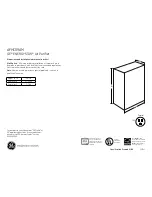
Split Type Installation Manual
20
12 Preparation for Use
This consists of the following steps:
• Checking for Leaks.
• Purging the installation.
• Start up.
• Troubleshooting.
12.1 Checking for leaks
Fig. 12.1 Checking for leaks in the installation.
Legend
1 Suction valve (gas)
2 Return valve (liquid)
3 Combined meter
4 Non-return joint
5 Pipes for coolant
6 Nitrogen cylinder
• Connect a combined meter (faucets) to the three-way
valve in the suction hose.
• Connect a nitrogen cylinder to the low-pressure end of
the combined meter.
• Carefully open the valves corresponding to the faucets
and pressurise the system.
• In the event of using R-410A coolant set it to 40
bar(g) of pressure, for 10/20 min.
• Check that all the connections and joints are
watertight.
• Close all the valves on the combined meter and
remove the nitrogen cylinder.
• Release the pressure from the system by slowly
opening the faucets.
• In the event of detecting leaks, repair them and repeat
the test.
Note!
According to Regulation 842/2006/EC,
the complete refrigerant circuit must be
periodically checked for leakage. Take the
necessary actions to ensure these tests are
performed and the results correctly logged into
the maintenance record of the machine. The
leakage test must be done with the following
frequency:
- Systems with less than 3 kg of refrigerant =>
periodic leakage test not needed.
- Systems with 3 kg or more of refrigerant => at
least once every 12 months.
- Systems with 30 kg or more of refrigerant =>
at least once every 6 months.
- Systems with 300 kg or more of refrigerant
=> at least once every 3 months.
12 Preparation for Use






































